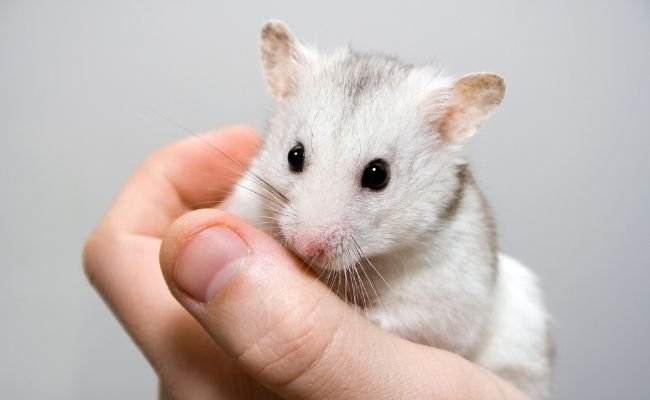All About Hamster Skin Conditions- Causes and Care Tips
Maintaining your hamster’s fur/skin healthy is essential to keeping your hamster happy and feeling comfortable. Hamsters are small animals, so their skin and fur can be damaged even more easily than larger pets like cats or dogs.
This article will cover some of the most common hamster skin conditions, but it is by no means an exhaustive list! If your hamster is experiencing a skin problem that you don’t see here, please consult with a veterinarian.
Common Skin/Fur Conditions In Hamsters
Some of the most common hamster skin and fur problems include:
- Mite Infestation
- Ringworms
- Dermatitis
- Hamster Hair Loss
- Skin Abscesses
- Bacterial Infections
- Skin Tumors

Mite Infestation
Mite infestations are a very common type of hamster skin condition. Hamster mites are tiny, eight-legged parasites that can cause intense irritation in your hamster. These pests feed on blood and tend to be located around the hamster’s ears, head, and neck area.
There are two types of mites that commonly affect pet hamsters:
- Fur mites
- Mange mites.
Fur mites usually cause scaly, round patches on the skin of the hamster. These patches are often gray, white, or yellow in color. Fur mites are extremely contagious between hamsters and can spread rapidly through a whole colony.
Mange mites typically cause scabs on your hamster’s body that can be as small as a pinhead or as large as a pencil eraser. Mange mites are less contagious than fur mites and tend to only affect one hamster at a time.
Signs of Mite Infestation in Hamsters:
- Rough, dry skin with scaly, white patches (fur mites)
- Bites all over the hamster’s body
- Small scabs on the hamster’s skin that resemble acne or bug bites
- An unpleasant odor coming from your hamster’s fur
If your hamster has mites, you will need to take it to a veterinarian for proper treatment. Without veterinary care, rodents such as hamsters can die of mite infestation.
Ringworms
Ringworm is caused by a fungal infection of the skin; it typically appears on the hamster’s head or feet. The fungus can spread rapidly through a whole colony, and will not go away without treatment.
Signs of Ringworm in Hamsters:
- Rough, scaly patches on the head or feet
- Small reddish-brown spots that resemble pimples but do not disappear when scratched
- A white, crusty ring around the infected area (similar to a ringworm infection on humans)
Ringworm infections are usually treated with an antifungal cream that must be applied to the hamster’s skin daily for several days.
If left untreated, ringworm can spread to other areas of the body and can even cause death. If you notice any signs of ringworm on your hamster, contact a veterinarian immediately.
Dermatitis
Another common type of hamster skin condition is dermatitis. Dermatitis typically occurs when the hamster’s skin becomes red and inflamed due to an outside stimulus.
There are many causes for dermatitis in hamsters. For example, an allergy to another animal can cause dermatitis. However, most cases of dermatitis in hamsters are caused by something inside the cage.
Some possible causes for dermatitis include; toys or accessories with sharp edges, dirty substrates like sawdust, wood chips, or cedar shavings, a dirty cage that can grow harmful bacteria, and an airtight container for transport.
Signs of Dermatitis In Hamsters
- Scratching and biting at affected areas (e.g. back, neck, legs)
- Redness and inflammation on the skin
- A bad odor coming from the hamster’s fur/skin
- Sores or wounds on the skin caused by excessive scratching
If the dermatitis is caused by something inside the cage, it should clear up within a few days if you clean out your hamster’s habitat thoroughly. If an allergy is to blame, consult with a veterinarian regarding appropriate treatments.
Hamster Hair Loss
Another common type of hamster fur condition is hair loss in hamsters. Although there are many reasons a hamster can experience hair loss, the easiest way to resolve it is by examining your hamster’s habitat for potential irritants.
Some possible causes of hair loss in hamsters include aggression from other pets, cage mates, allergies, boredom, and inappropriate substrate (e.g. not using a hamster ball), which can cause the fur to get caught and torn off by the wheel or other cage accessories.
Signs of Hair Loss in Hamsters
- Hair falling off in clumps (visible on the floor of the habitat)
- Scabs and sores caused by excessive scratching
- A bad odor coming from your hamster’s fur
Symptoms typically occur over time rather than suddenly. Once you remove whatever is causing the hair loss, your hamster should begin to recover.
Skin Abscesses
Skin abscesses are also a common type of hamster skin condition. A skin abscess is an infected, pus-filled lump on your hamster’s body that occurs when bacteria enters a wound caused by another problem, such as mites or biting.
Signs of Skin Abscesses in Hamsters:
- Skin lumps that feel like marbles underneath the fur
- A yellowish discharge oozing from your hamster’s skin
- Bad odor coming from your hamster’s fur (similar to a dog with an infected bite)
Antibiotics and antifungal medications can be prescribed by a veterinarian for skin abscesses. Abscesses are often painful for hamsters, so your veterinarian may also prescribe pain medication.
Bacterial Infections in Hamsters
A bacterial infection is the result of common bacteria entering your hamster’s body through an open wound. These infections are rarer than other types of skin conditions, but must be treated immediately to prevent serious complications.
Signs of a Bacterial Infection in Hamsters:
- Fever
- Swelling around the face or neck area
- Open sores with yellow discharge oozing from them (similar to dog bites)
Bacterial infections are often caused by unclean living conditions, so you may also want to clean your hamster’s cage more thoroughly.
If your hamster has any of these symptoms, you should immediately contact a veterinarian. When left untreated, a bacterial infection can cause a wide array of problems, including meningitis and pneumonia.
Skin Tumors in Hamsters
Skin tumors are a serious type of hamster skin condition that should be examined by a veterinarian as soon as possible. Skin tumors can either be malignant or benign.
Malignant tumors are cancerous and usually appear as a lump or red sore on your hamster’s body. If left untreated, malignant tumors will continue to grow and can spread to other areas of the body through blood vessels.
Benign tumors are non-cancerous lumps that may turn into cancer if they are not removed. Benign tumors often appear gray or white with an irregular shape.
Signs of Skin Tumors in Hamsters:
- A large swelling on your hamster’s body
- Lumps underneath the skin
- Open sores or rashes that don’t heal after several days
If you notice any of these symptoms, contact a veterinarian immediately. Your veterinarian will be able to determine the type of tumor your hamster has through a biopsy or other tests.
How To Keep Your Hamsters Skin Healthy
As always, the key to keeping your hamster’s skin healthy is to keep its living area clean and free of irritants. Here are some tips for preventing or treating common hamster skin conditions:
Regularly Examine Your Pet’s Skin

Next, check your hamster’s fur daily for signs of infection and disease. Frequent examinations can alert you to problems before they become serious.
If your hamster starts scratching or biting their skin, take it to a veterinarian immediately to determine the cause of the irritation. Itching is often an early sign of mites or other types of infection.
Keep The Environment Clean
First, make sure that your hamster’s cage is cleaned out daily. Dirty cages can cause mites, bacteria, and other types of infection. Cleaning your hamster’s cage once a week should be enough to keep them from all the potential threats.
However, if your hamster pet is already suffering from a skin condition, cleaning needs to come more often. Again, always make sure that you use mild cleaning supplies (preferably natural) to avoid irritating your hamster’s skin.
Keep Your Hamster Up To Date On Vaccinations
Also, keep your pet’s vaccinations up to date. Vaccinations can greatly reduce the chance of infections, especially if your hamster comes into contact with other wild rodents.
Proper Diet Is Also Very Important
A diet rich in protein and fat is often recommended for pets with skin conditions because it boosts the immune system. Malnutrition can cause problems with the skin, so make sure you are always providing the best diet for your hamster.
Foods containing carotene will also help to promote healthy skin and fur, including carrots, leafy greens, sweet potatoes, squash, apricots, cantaloupe.
Be Careful With Hamster Wounds
Also, if you notice any cuts or wounds on your hamster’s body, be sure to tend them right away in order to prevent infection. If your hamster does get an open cut, clean it daily with saline solution in order to prevent bacteria from entering the wound.
These are just a few of the ways that you can keep your hamster’s skin and fur healthy and clean. Remember that these steps aren’t always enough to treat serious infections or diseases; if you notice any changes in your pet, take them to a veterinarian immediately.
Final Verdict:
Your hamster’s skin can be a great indicator of its overall health and well-being. Unfortunately, these creatures are also very susceptible to a variety of skin problems. However, many of these issues can be prevented, if not treated, with a few simple steps.
If you notice any changes in your hamster’s skin or fur, take them to a veterinarian immediately for diagnosis and treatment. While some cases will be able to heal on their own, others may need medication or surgery. In the end, your hamster’s health is always most important.







